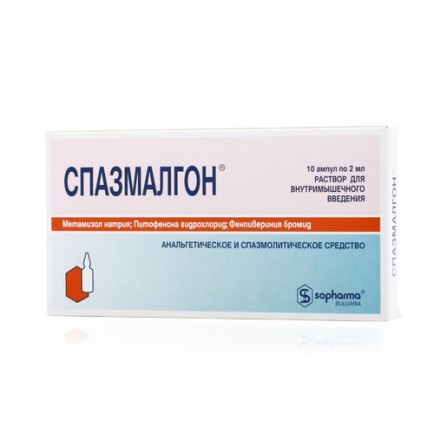Spasmalgon solution for intramuscular injection
Condition: New product
1000 Items
Rating:
Be the first to write a review!

More info
Active ingredients
Metamizole sodium + Pitofenon + Fenpiverinium bromide
Release form
Solution
Composition
Solution for intramuscular injection, composition (1 ml): active substances: Metamizole sodium - 500 mg phenopiverinium bromide - 0.02 mg pypithenone hydrochloride - 2 mg adjuvants: water for injection - up to 1 ml
Pharmacological effect
Pharmacokinetics
Indications
The preparation includes: non-narcotic analgesic metamizole sodium, myotropic antispasmodic pitofenone and m-anticholinergic blocking agent fenpiverinium bromide. Metamizole sodium is a derivative of pyrazolone. It has analgesic, antipyretic and anti-inflammatory effects. Pitofenone is similar to papaverine, has a direct myotropic effect on the smooth muscles of internal organs and causes its relaxation. relieve pain, relax smooth muscles, reduce fever.
Contraindications
V / m. Enter 2–5 ml 2-3 times per day. Before the injection of the injection solution, the ampoule should be warmed in your hand. The duration of treatment is no more than 5 days. The maximum daily dose is no more than 10 ml (respectively, 5 g of metamizole sodium). In the absence of a therapeutic effect, the drug is discontinued, and, with good or satisfactory effect, is transferred to oral or rectal use.
Use during pregnancy and lactation
Symptoms: vomiting, feeling of dryness in the mouth, decreased sweating, disturbed accommodation, decreased blood pressure, drowsiness, confusion, impaired liver and kidney function, convulsions. Treatment: gastric lavage, the appointment of activated carbon, symptomatic therapy.
Dosage and administration
The drug Spasmalgon in the form of a solution for injections is used to relieve pronounced pain syndrome caused by spasms of smooth muscles, including: Spasm of smooth muscles of the ureter and bladder,as well as renal colic, which are accompanied by pain syndrome of weak and moderate intensity. Liver and biliary tract diseases, which are accompanied by severe pain syndrome, including hepatic (biliary) colic, biliary dyskinesia, Oddi's sphincter dysfunction (post-cholecystectomy syndrome). intestinal tract, which are accompanied by pains of a spastic nature, including intestinal colic and chronic colitis. Diseases of the pelvic organs, which are accompanied by pain syndrome intensivnosti.Kupirovanie mild to moderate pain in the primary and secondary dysmenorrhoea.
Side effects
Precautionary measures
Overdose
Simultaneous use with radiopaque drugs, colloid blood substitutes and penicillin is contraindicated. Simultaneous use of the drug with cyclosporine decreases the concentration of the latter in the blood. With simultaneous use of phenylbutazone, barbiturates and other inducers of liver microsomal enzymes, decrease Metamizole sodium is effective. When used simultaneously with other non-narcotic analgesics, tricyclic antidepressants, pp, oral hormonal contraceptives, and allopurinol, toxicity may be increased. .In case of simultaneous use, the effect of the drug is enhanced by codeine, blockers of histae. new H2 receptors and propranolol (slow down inactivation). With simultaneous use of drugs with myelotoxic effect, they increase the hematotoxic effect of Spasmalgone. . Use in conjunction with chlorpromazine or other derivatives.phenothiazine can lead to the development of severe hyperthermia. With simultaneous use, Spasmalgon enhances the effects of ethanol. Pharmaceutical interaction Due to the high probability of development of pharmaceutical incompatibility, it cannot be mixed with other drugs in the same syringe.
Interaction with other drugs
hypersensitivity to pyrazolone derivatives (butadion, tribuzone), other components of the drug, marked impaired liver or kidney function, inhibition of bone marrow hematopoiesis, stable and unstable angina, chronic heart failure in the stage of decompensation, tachyarrhythmia, closed-angle form of glaucoma, hyperplasia, and an object template; and megacolon; granulocytopenia; deficiency of glucose-6-phosphate dehydrogenase; pregnancy and lactation period; children under 6 years old. With caution: l gkaya and average severity of impaired liver or kidney function; a tendency to hypotension (systolic pressure below 100 mm Hg); propensity to bronchospasm; increased individual sensitivity to nonsteroidal anti-inflammatory drugs or non-narcotic analgesics.
special instructions
On the part of the digestive system: burning sensation in the epigastric region, dry mouth. From the nervous system: headache, dizziness, anticholinergic effects (decreased sweating, accommodation paresis, difficulty urinating). From the side of the cardiovascular system: decreased blood pressure, tachycardia , cyanosis. From the urinary system: impaired renal function, oliguria, anuria, proteinuria, interstitial nephritis, urine staining in red. From the side of blood-forming organs: during Allergic reactions: urticaria, bronchospastic syndrome, anaphylactic shock, Quincke edema, erythema multiforme exudative (including Stevens-Johnson syndrome), toxic epidermal necrosis (erythema syndrome), including toxic epidermal erythema (including Stevens-Johnson syndrome), toxic epidermal necrosis (erythema syndrome), including toxic epidermal erythema (including Stevens-Johnson syndrome), toxic epidermal necrosis (erythema syndrome), including toxic epidermal erythema (including Stevens-Johnson syndrome), toxic epidermal necrosis (erythema syndrome), including toxic epidermal erythema (including Stevens-Johnson syndrome), toxic epidermal necrosis (erythema syndrome), including toxic epidermal neuritis (erythema syndrome (including Stevens-Johnson syndrome), toxic epidermal necrolysis, erythema syndrome (including Stevens-Johnson syndrome);




